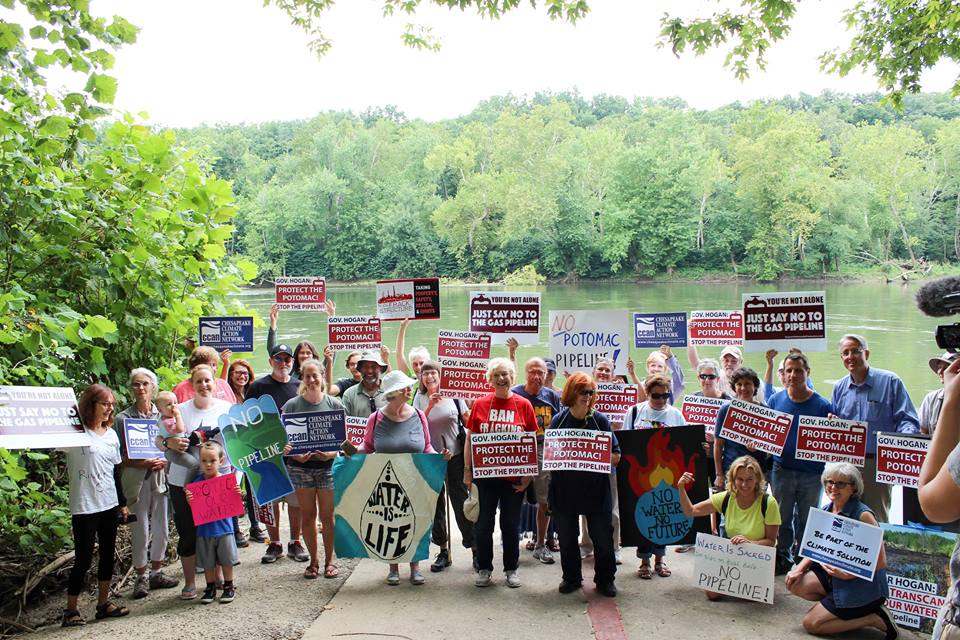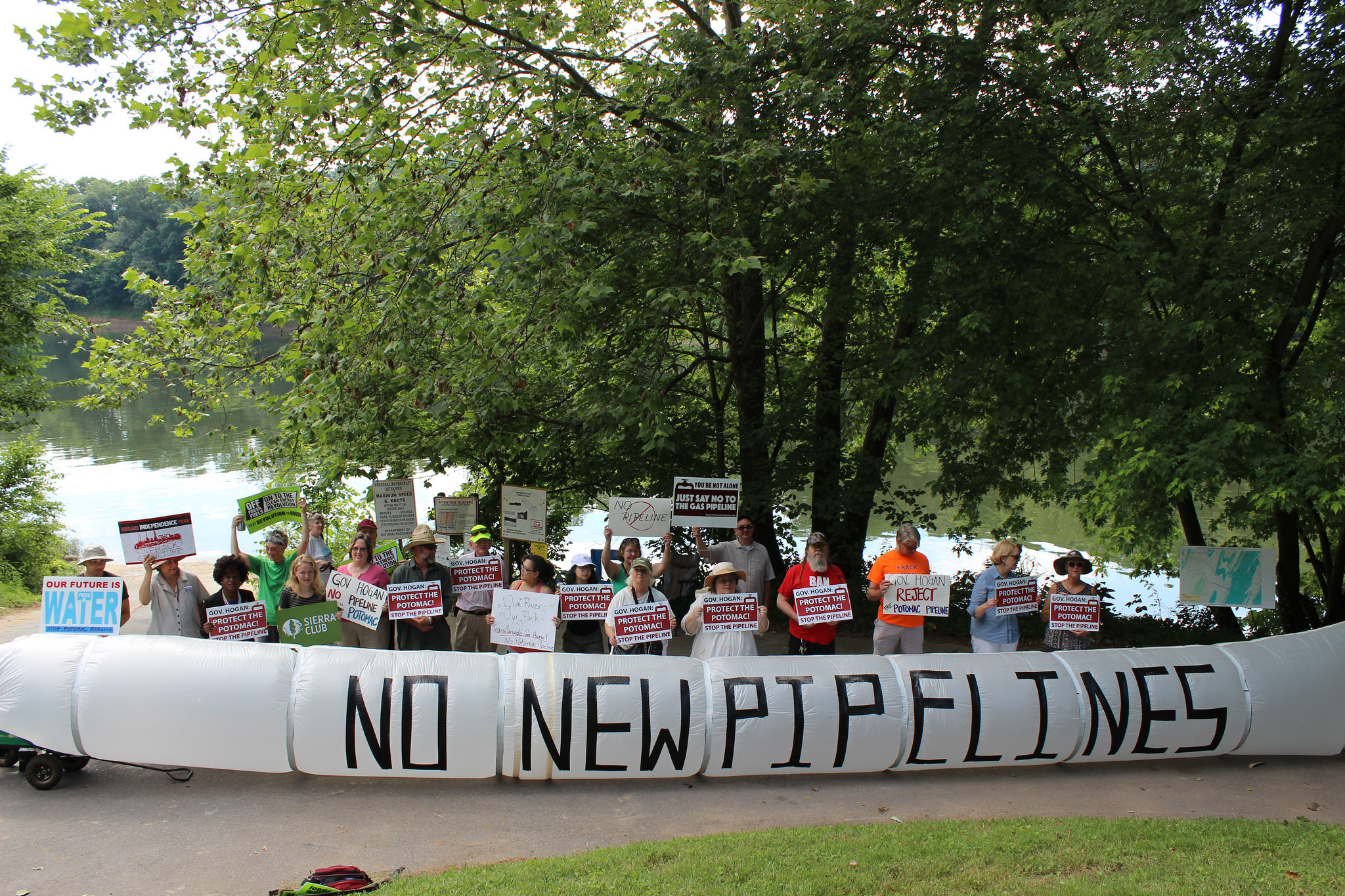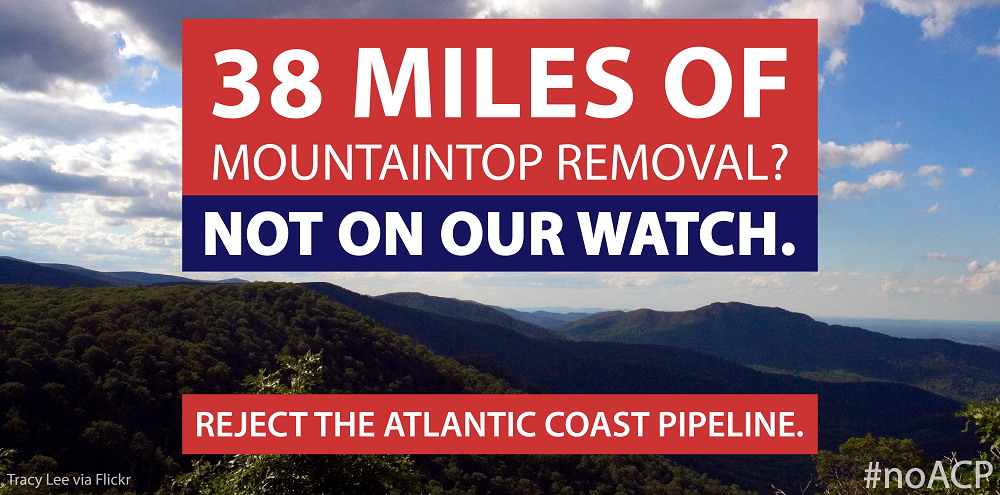Two weeks ago, more than 300 hundred activists joined hand-in-hand on a bridge spanning the Potomac River, uniting West Virginia and Maryland in solidarity against TransCanada’s proposed fracked-gas pipeline under the Potomac.
The power and beauty of this moment brought me to tears and filled me with hope. When we are united, we can fight Big Oil and Gas and truly WIN!
Now that we’ve joined hands, it’s time to roll up our sleeves and stop this pipeline once and for all!
Chesapeake Climate Action Network, alongside other members of the “No Potomac Pipeline” coalition, will be holding community meetings throughout Western Maryland and West Virginia over the next couple weeks. Join us to learn the next steps in stopping the Potomac Pipeline! (Keep reading for meeting location/date details.)
After our historic fracking ban victory, Maryland is once again being threatened by fracked gas. TransCanada — the same company behind the Keystone XL pipeline, and who spilled over 16 thousand gallons of crude oil on South Dakota farmland — is trying to build a pipeline that would transport fracked gas between Pennsylvania and West Virginia. They want to do this with the shortest, cheapest, and most dangerous route possible. The “Eastern Panhandle Expansion” project would cut underneath the Potomac River that serves as the source of drinking water for millions of residents in our state and beyond.
Already, the oil companies are suing landowners to force the pipeline through their farmland. This pipeline would threaten the health of our drinking water and well-being of our communities. It would also deepen our dependence on dirty fossil fuels and fracking for years to come. By trying to force a pipeline through Sleepy Creek, Back Creek, and underneath the Potomac, we know that they are putting our families, our water, and our climate at risk.
We’re not going to let this happen.
Join us at a community meeting to learn how to stop this pipeline. During the meetings, we will talk about ways that we can raise our voices in our local communities, reach out to our neighbors, and make sure that our local elected leaders hear loud and clear that Marylanders say NO to the Potomac Pipeline.
Join us to learn how you can become part of a pipeline-free future for West Virginia and Maryland! Follow the links below to RSVP.
Eastern Panhandle: Wednesday, November 1, 6:30 pm in Martinsburg WV
Frederick County: Monday, November 6, 6:30 pm in Frederick MD
Washington County: Wednesday, November 8, 6:30 pm in Hagerstown MD
Western Maryland: Sunday, November 12, 4:00 pm in Frostburg MD
From Standing Rock to Hancock: Camp Out To Oppose The Potomac Pipeline!
From Standing Rock to Hancock, Maryland, citizens are rising up to resist fracked-gas pipelines in their communities. That’s right: Western Maryland is now under threat from a Dakota-esque pipeline. It’s being proposed by the infamous energy giant TransCanada of Keystone XL fame.
TransCanada — the same company that recently spilled over 16 thousand gallons of crude oil on South Dakota farmland — now wants to build a pipeline that would transport fracked gas between Pennsylvania and West Virginia.They want to do this with the shortest, cheapest, and most dangerous route possible. The Eastern Panhandle Pipeline expansion project would cut through Hancock, Maryland and underneath the Potomac River that serves as the source of drinking water for millions of residents in our state and the DC suburbs.
We are not going to allow this to happen.
This summer, we are forming a resistance to stop the Pipeline under the Potomac. We will do this by staging camp outs along the C&O Canal throughout the summer to draw attention to the many groups, concerned citizens, and elected officials who are opposed to endangering the drinking water of millions for a pipeline that wouldn’t even benefit Maryland citizens. We’ll be calling on Governor Hogan to deny the permit that would allow TransCanada to drill under the Potomac in Maryland.
We were able to ban fracking in Maryland because each one of you dedicated your time, your energy, and your activism to protect Maryland from fracking. Now it’s time once again to roll up our sleeves and call on Governor Hogan to complete the fracking ban — which means stopping this pipeline!
Sign up to camp out today for a frack-free future tomorrow.
Here are the details:
Weekend 1
Date: Friday/Saturday, June 30-July 1
Location: McCoy’s Ferry Campground
Start Time: 12:00 pm
Sponsoring Organization: Potomac Riverkeepers
Organizational Contact: Brent Walls, Brent@potomacriverkeeper.org
Weekend 2
Date: Saturday, July 8th
Location: McCoy’s Ferry Campground
Start Time: 1:00 p.m.
Sponsoring Organization: Food and Water Watch
Organizational Contact: Rianna Eckel, reckel@fwwatch.org
Weekend 3
Date: Friday, July 14th
Location: Paw Paw Campground
Start Time: 2:00 pm
Details: Join for a splashing good time in the Potomac River at the Paw Paw Campground along the C&O canal. Bring your family and friends to a great swimming hole on the Potomac and enjoy some hot dogs and hamburgers. Stay the night at the campgrounds and hear more about our fight against the pipeline under the Potomac. The following morning there will be a guided talk of the Paw Paw Tunnel by the National Park Service. The goal is to have enough people at this event to stretch across the Potomac River from Maryland to West Virginia to show that we stand as a united front.
Sponsoring Organization: Potomac Riverkeepers
Organizational Contact: Brent Walls, Brent@potomacriverkeeper.org
Weekend 4
Date: Friday, July 21st
Location: C&O Canal Boat Launch (just past the 120 mile marker)
Time: 6:00 p.m.
Sponsoring Organization: Eastern Panhandle Protectors
Organizational Contact: Laura Steepleton, lnsteep@gmail.com
Weekend 5
Date: Friday, July 28th
Location: Antietam Creek Campsite
Start Time: 12:00 p.m.
Sponsoring Organization: Chesapeake Climate Action Network
Organizational Contact: Brooke Harper, brooke@chesapeakeclimate.org
Weekend 6
Date: Saturday, August 5th
Location: McCoys Ferry Campground
Start Time: 1:00 p.m.
Details: Activities will include our outings program: hiking, bike tours, etc. – Highlighting our Climate Parents program.
Sponsoring Organization: The Sierra Club Maryland Chapter
Organizational Contact: Zack Gerdes, Zack.Gerdes@mdsierra.org
Click here to sign up for a campout weekend — or email the organizers (listed above) directly!
Dominion’s Atlantic Coast Pipeline Would Require Extensive Mountaintop Removal
New research exposes how Dominion’s proposed Atlantic Coast Pipeline would decapitate 38 miles of ridgelines in Virginia and West Virginia. Evidence will show project is OPPOSITE of “environmentally friendly” and states must reject it
RICHMOND, VA — A briefing paper released today details how Dominion Resources intends to blast away, excavate, and partially remove entire mountaintops along 38 miles of Appalachian ridgelines as part of the construction of the Atlantic Coast Pipeline. Engineering and policy experts have examined documents submitted by Dominion to the Federal Energy Regulatory Commission (FERC) and, using GIS mapping software, found that Dominion would require mountaintops to be “reduced” by 10 to 60 feet along the proposed route of the pipeline. For perspective, the height equivalent of a five-story building would be erased in places from fully forested and ancient mountains.
Furthermore, Dominion has yet to reveal how it intends to dispose of at least 247,000 dump-truck-loads of excess rock and soil—known as “overburden”—that would accumulate from the construction along just these 38 miles of ridgetops.
“In light of the discovery that the Atlantic Coast Pipeline will cause 10 to 60 feet of mountaintops to be removed from 38 miles of Appalachian ridges, there is nothing left to debate,” said Mike Tidwell, Executive Director of the Chesapeake Climate Action Network. “Dominion’s pipeline will cause irrevocable harm to the region’s environmental resources. With Clean Water Act certifications pending in both Virginia and West Virginia, we call on Virginia Governor Terry McAuliffe and West Virginia Governor Jim Justice to reject this destructive pipeline.”
Dominion has submitted a proposal to FERC to build a 42-inch diameter pipeline that would transport natural gas from West Virginia into Virginia and North Carolina. Dominion has attempted to paint the Atlantic Coast Pipeline as an “environmentally-friendly” project. However, its proposed construction method and route selection across and along steep mountains is unprecedented for the region—if not the country—and is viewed as extreme and radical by landowners, conservationists, and engineers. Similar impacts – although not yet fully inventoried – could come from the construction of a second pipeline to the south: the Mountain Valley Pipeline led by the company EQT Midstream Partners, LP.
“The Atlantic Coast Pipeline could easily prove itself deadly,” said Joyce Burton, Board Member of Friends of Nelson. “Many of the slopes along the right of way are significantly steeper than a black diamond ski slope. Both FERC and Dominion concede that constructing pipelines on these steep slopes can increase the potential for landslides, yet they still have not demonstrated how they propose to protect us from this risk. With all of this, it is clear that this pipeline is a recipe for disaster.”
The briefing paper released today was prepared by the Chesapeake Climate Action Network in coordination with the Allegheny-Blue Ridge Alliance, Friends of Nelson, Appalachian Mountain Advocates, and the Dominion Pipeline Monitoring Coalition. It cites data from the Draft Environmental Impact Statement prepared by the Federal Energy Regulatory Council (FERC) as well as information supplied to FERC by Dominion. It also compiles information from GIS (Geographic Information System) mapping software and independent reports prepared by engineers and soil scientists.
Key findings include:
- Approximately 38 miles of mountains in West Virginia and Virginia will see 10 feet or more of their ridgetops removed in order to build the Atlantic Coast Pipeline.
- This figure includes 19 miles in West Virginia and 19 miles in Virginia.
- The majority of these mountains would be flattened by 10 to 20 feet, with some places along the route requiring the removal of 60 feet or more of ridgetop.
- Building the ACP on top of these mountains will result in a tremendous quantity of excess material, known to those familiar with mountaintop removal as “overburden.”
- Dominion would likely need to dispose of 2.47 million cubic yards of overburden, from just these 38 miles alone.
- Standard-size, fully loaded dump trucks would need to take at least 247,000 trips to haul this material away from the construction site.
“It is astounding that FERC has not required Dominion to produce a plan for dealing with the millions of cubic yards of excess spoil that will result from cutting down miles of ridgetop for the pipeline,” said Ben Luckett, Staff Attorney at Appalachian Mountain Advocates. “We know from experience with mountaintop removal coal mining that the disposal of this material has devastating impacts on the headwater streams that are the lifeblood our rivers and lakes. FERC and Dominion’s complete failure to address this issue creates a significant risk that the excess material will ultimately end up in our waterways, smothering aquatic life and otherwise degrading water quality. Without an in-depth analysis of exactly how much spoil will be created and how it can be safely disposed of, the states cannot possibly certify that this pipeline project will comply with the Clean Water Act.”
“Even with Dominion’s refusal to provide the public with adequate information, the situation is clear: The proposed construction plan will have massive impacts to scenic vistas, terrestrial and aquatic habitats, and potentially to worker and resident safety,” said Dan Shaffer, Spatial Analyst with the Dominion Pipeline Monitoring Coalition. “There is no way around it. It’s a bad route, a bad plan, and should never have been seriously considered.”
The full briefing paper is available here.
CONTACT:
Denise, 240-396-2022, denise@chesapeakeclimate.org
Anne Havemann, 240-396-1984, anne@chesapeakeclimate.org
Briefing-Paper-Mountaintop-Removal-to-Build-ACP
Urge Obama to end Mountaintop Removal Coal Mining!
Below is an email I received from Matt Wasson from http://www.ilovemountains.org

The pressure on the Obama administration to stop mountaintop removal coal mining is building across the country.
Last week, we asked you to call the White House and tell the administration that it was time to reverse the devastating 2002 Bush Administration “fill rule,” which allows coal companies to dump their toxic mining waste into our nation’s streams.
And next week, on June 23rd, climate scientist Dr. James Hansen will join community members and activists from around the country in Coal River Valley, West Virginia to launch a year of activism to end mountaintop removal coal mining.
Hansen and others will gather at Marsh Fork Elementary — the elementary school that is next to a mountaintop removal mine operated by Massey Energy and just 400 yards downslope from a 2.8 billion gallon coal sludge impoundment that threatens the school.
The activists will then march a short distance to Massey Energy’s office of operations and risk arrest in a line crossing civil disobedience, in order to raise awareness of the devastation that mountaintop removal coal mining is causing to the mountains and communities of Appalachia.
Can you take a moment to stand with them, and help put pressure on the Obama administration to take immediate action to end mountaintop removal coal mining today?
We’re asking every member of iLoveMountains.org to take just three minutes to email the White House to ask President Obama to immediately begin the process of overturning the Bush-era “fill rule,” which allows coal companies to dump their toxic mining waste into our nation’s streams.
Please, click here to email President Obama now.
The Obama administration needs to hear that simply enforcing Bush-era rules and laws is not enough. The administration must overturn the Bush-era rules to begin the process of building a sustainable future for Appalachia.
That’s why the activists gathering at Coal River Valley next week are risking arrest — to send the message that impact on the mountains, communities and waterways of central Appalachia have been ignored for too long.
Please, take a moment to make sure President Obama hears that message:
Email President Obama today.
Thank you for taking action.
Matt Wasson
iLoveMountains.org
PS Contact Annie Sartor (annie@ran.org) at Rainforest Action Network if you are interested in coming to Coal River Mountain on June 23rd.
Just when I thought things couldn't get worse in Virginia…
As the rest of the nation rejects coal plant after coal plant… Virginia is building one in SW and proposing another one three times the size in the Hampton Roads area.
As our neighbors in Maryland pass the strongest state legislation to regulate carbon emissions… Virginia’s own Rick Boucher is working to water down and nullify any impact a federal climate bill could have.
It’s a tough fight here in Virginia, and I will continue to fight every single day to promote sustainable energy policy for the commonwealth.
Amidst it all, I still remember things could be worse, we could be WEST VIRGINIA!

Our friends in West Virginia just declared coal the state rock.
Cross posted from our friends at Center for American Progress’s Blog:
Gov. Joe Manchin (D-WV) has made coal the official state rock of his state. According to the West Virgina Coal Association, the teen-aged daughter of a coal company employee “got the measure placed before the state legislature this year with the help of Sen. Truman Chafin (D-Mingo) and Del. Harry Keith White (D-Mingo).” On Wednesday, Manchin signed the resolution into law:
Bituminous coal is now West Virginia’s official state rock. Gov. Joe Manchin has signed a House of Delegates resolution making the designation based primarily on coal’s contribution to the state’s economy and history.
Despite $118 million in coal-mining annual income, West Virginia has the nation’s lowest median household income, worst educational services, worst social assistance, the highest population with disabilities, and nearly a quarter of West Virginia children in poverty.
Seems to me the best way to preserve the state rock is to keep it in the GROUND! Who’s with me?
Economics support wind power… Gov Manchin supports???

Coal River Mountain Watch released a report yesterday that shows that wind development is a better economic land use option than mountaintop removal coal mining, not only for Coal River Mountain, but potentially for all areas in southern West Virginia that exhibit good wind potential.



